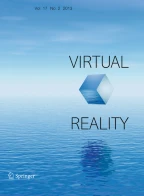Abstract
This paper describes a real-time welding simulation method for use in a desktop virtual reality simulated Metal Inert Gas welding training system. The simulation defines the shape of the weld bead, the depth of penetration, and the temperature distribution in the workpiece, based on inputs from the motion-tracking system that tracks the position of the welding gun as a function of time. A finite difference method is used to calculate the temperature distribution, including the width of the weld bead and the depth of penetration. The shape of the weld bead is then calculated at each time step by assuming a semi-spherical volume, based on the width of the weld bead, the welding speed, and the wire feed rate. The real-time performance of the system is examined, and results from the real-time simulation are compared to physical tests and are found to have very good correlation for welding speeds up to 1,000 mm/min.
Similar content being viewed by others
Explore related subjects
Discover the latest articles, news and stories from top researchers in related subjects.References
Aglawe A (2008) Virtual MIG welding simulation. M.S. Thesis, University of Louisiana at Lafayette, December, 2008
Chan B, Pacey J, Bibby M (1999) Modelling gas metal arc weld geometry using artificial neural network technology. Can Metall Q 38:43–51
Davoud MS, Deng X (2003) A comparison between three- and two dimensional thermal finite element analysis of the gas metal arc welding process. In: Proceedings of IMECE’03, Washington, DC, pp 123–130
Dorzin E (2003) Temperature of a MIG welder. In: Elert G (ed) The physics factbook. Available on-line at: http://hypertextbook.com/facts/2003/EstherDorzin.shtml. Accessed June, 2009
ETB (2005) Melting temperatures of some common metal and alloys. The engineering toolbox. Available on-line at: http://www.engineeringtoolbox.com/melting-temperature-metals-d_860.html. Accessed June, 2009
Fan HG, Kovacevic R (1998) Dynamic analysis of globular metal transfer in gas metal arc welding-a comparison of numerical and experimental results. J Phys D Appl Phys 31:2929–2941
Fast K, Gifford T, Yancey R (2004) Virtual training for welding. In: Proceedings of the third IEEE and ACM international symposium on mixed and augmented reality (ISMAR 2004), Washington, DC, pp 298–299. Symposium on Mixed and Augmented Reality. IEEE Computer Society, Washington, DC, 298–299. doi:10.1109/ISMAR.2004.65
Jones LA, Mendez P, Weiss D, Eager TW (1997) Dynamic behavior of gas metal arc welding. In: 9th Annual conference on iron and steel technology, Phoang, Korea
Kim IS, Basu A (1998) A mathematical model of heat transfer and fluid flow in the gas metal arc welding process. J Mater Process Technol 77:17–24
Kim G-H, Kang S-I, Lee S-B (1999) A study on the estimate of weld bead shape and the compensation of welding parameters by considering weld defects in horizontal fillet welding. In: Knowledge-based intelligent information engineering systems third international conference, pp 212–216
Kumar S, Bhaduri S (1994) Three-dimensional finite element modeling of gas metal-arc welding. Metallur Mater Trans B 25:435–441
Lee CK, Candy J, Tan CPH (2004) Measurement and finite element analysis of temperature distribution in arc welding process. Int J Comput Appl Technol 21(4):171–177
Mavrikios D, Karabatsou V, Fragos, Chryssolouris G (2006) A prototype virtualreality-based demonstrator for immersive and interactive simulation of welding process. Int J Comput Integr Manuf 19:294–300
Patankar SV (1980) Numerical heat transfer. Hemisphere, New York
Porter NC, Cote J, Allan G, Timothy D, Lam W (2006) Virtual reality welder training. J Ship Prod 22:126–138
Wang G, Huang PG, Zhang YM (2003) Numerical analysis of metal transfer in gas metal arc welding. Metallur Mater Trans B 34:345–353
White S, Prachyabrued M, Chambers TL, Reiners D, Borst C (2010) Low cost simulated MIG welding for advancement in technical training. Virtual Reality. Special Issue in Manufacturing and Construction. doi:10.1007/s10055-010-0162-x
WTIA (2006) Work instructions for macro examination of welds. Welding Technology Institute of Australia, Document no. TGN-RT-04. Available on-line at: http://www.wtia.com.au/pdf/TGN-RT-04%20Work%20Instruction%20for%20Macro%20Examination.pdf. Accessed June, 2009
Wu CS, Zhang MX, Li KH, Zhang YM (2007) Numerical analysis of double-electrode gas metal arc welding process. Comput Mater Sci 39:416–423
Zeng Z, Wang L, Wang Y, Zhang H (2009) Numerical and experimental investigation on temperature distribution of the discontinuous welding. Comput Mater Sci 44(4):1153–1162
Zhang W, Kim C-H, DebRoy T (2004) Heat and fluid flow in complex joints during gas metal arc welding-part I: numerical model of fillet welding. J Appl Phys 95:5210–5219
Acknowledgments
This work was funded by the Louisiana Workforce Commission, and their contribution is gratefully acknowledged.
Author information
Authors and Affiliations
Corresponding author
Rights and permissions
About this article
Cite this article
Chambers, T.L., Aglawe, A., Reiners, D. et al. Real-time simulation for a virtual reality-based MIG welding training system. Virtual Reality 16, 45–55 (2012). https://doi.org/10.1007/s10055-010-0170-x
Received:
Accepted:
Published:
Issue Date:
DOI: https://doi.org/10.1007/s10055-010-0170-x
